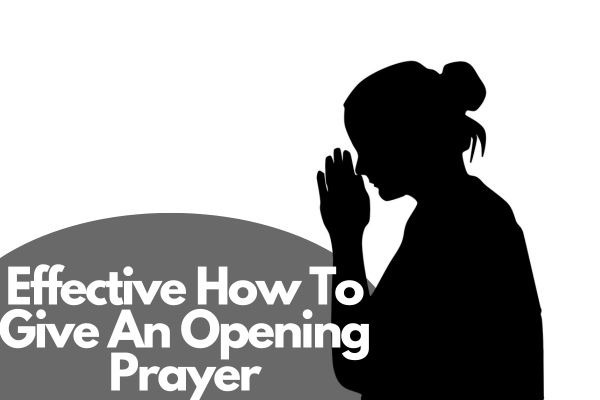In this comprehensive guide, we’ll explore the steps to on How To Give an Opening Prayer that resonates with your audience.
Opening prayers hold significant importance in various religious and spiritual gatherings. They set the tone, invoke blessings, and provide a sense of unity among those present.
Whether you’re a seasoned clergy member or someone asked to lead a prayer for the first time, knowing how to give an opening prayer is a valuable skill.
Contents
1. How To Give An Opening Prayer
Before diving into the practical aspects, it’s crucial to grasp why opening prayers matter. These prayers serve as a bridge between the mundane and the sacred, creating a reverent atmosphere and inviting the divine presence into the gathering. An effective opening prayer can comfort, inspire, and unify those in attendance.
Preparing Yourself Mentally and Spiritually
To give a heartfelt opening prayer, you must prepare yourself mentally and spiritually. Take time to reflect, meditate, and connect with your own spirituality. This inner preparation will shine through in your prayer and make it more sincere.
Selecting the Right Words and Tone
Selecting the right words and tone for an opening prayer is essential to set the desired atmosphere and convey the intended message. Here are some tips to help you choose the appropriate words and tone for an opening prayer:
1. Understand the Audience
Consider the beliefs, values, and preferences of the audience you are addressing. Tailor your words to resonate with their understanding and beliefs, keeping in mind that the audience may be diverse.
2. Be Inclusive
Use inclusive language that welcomes and respects all individuals present, regardless of their background or beliefs. Avoid language that may alienate or exclude anyone.
3. Tone of Reverence
Maintain a tone of reverence and humility. Approach the prayer with a sense of awe and respect for the divine, recognizing the solemnity of the occasion.
4. Clarity and Simplicity
Choose words that are clear and easy to understand. Avoid overly complex or archaic language that might be difficult for the audience to follow.
5. Be Concise
Keep the opening prayer concise and to the point. While it’s essential to convey your message, overly long prayers can lose the attention of the audience.
6. Express Gratitude
Begin the prayer by expressing gratitude. Thank the divine, a higher power, or the universe for the opportunity to gather and seek guidance.
7. Set a Positive Tone
Focus on positive and uplifting themes, such as hope, unity, peace, and love. Encourage a sense of joy and inspiration in your words.
8. Reflect on the Purpose
Align the words and tone of the prayer with the purpose of the gathering or event. Whether it’s a celebration, a solemn occasion, or a meeting, make sure your prayer sets the right mood.
Setting the Mood
Setting the mood for an opening prayer is essential to create the right atmosphere for a gathering, event, or meeting. Here are some tips to help you set the mood effectively:
1. Understand the Occasion
Before crafting your opening prayer, consider the nature of the event or gathering. Is it a celebration, a solemn occasion, a meeting, or a significant milestone? Tailor your prayer to the specific occasion.
2. Express Gratitude
Begin your prayer with words of gratitude. Express thanks for the opportunity to come together and acknowledge any blessings or positive aspects associated with the occasion.
3. Invoke Reverence
Set a tone of reverence and solemnity. Use words and phrases that convey respect for the divine, the purpose of the gathering, and the importance of the moment.
4. Reflect the Purpose
Align the mood with the purpose of the event. If it’s a joyful celebration, infuse your prayer with positivity and happiness. For a more solemn occasion, convey a sense of reflection and reverence.
5. Use Uplifting Language
Choose words and phrases that inspire and uplift the audience. Encourage a sense of hope, unity, and purpose in your prayer.
6. Address Challenges
If the occasion involves challenges or difficulties, acknowledge them in your prayer. Seek strength, guidance, and wisdom to overcome these challenges while maintaining a sense of resolve.
Structuring Your Opening Prayer
An opening prayer typically follows a specific structure:
1. Begin with Gratitude
Express gratitude for the opportunity to pray and gather. Acknowledge the blessings and privileges everyone shares.
2. Address the Divine
Invoke the divine presence by addressing your chosen deity or higher power. This is where personal faith and beliefs come into play.
3. Include the Congregation
Incorporate the congregation into your prayer. Pray for their well-being, unity, and intentions.
4. Offer Petitions and Intercessions
Ask for guidance, blessings, and protection, both for individuals and the collective.
5. End with a Closing Statement
Conclude your prayer with a thoughtful statement that ties everything together. This can be a blessing, a quote, or a call to action.
Practice Makes Perfect
Practice your opening prayer beforehand. Familiarity with your words and delivery will help reduce nervousness and ensure a smoother delivery.
Delivering Your Opening Prayer
When delivering the prayer:
1. Maintain Eye Contact
Engage with the audience by maintaining eye contact. It conveys sincerity and connection.
2. Speak Clearly and Calmly
Articulate your words clearly and at a comfortable pace. A calm demeanor will help set a reassuring tone.
3. Use Appropriate Gestures
Subtle gestures can enhance your prayer. Folded hands, a gentle bow, or raised palms can convey reverence.
Dealing with Nervousness
Dealing with nervousness during an opening prayer, especially in a public or group setting, is a common experience. Here are some tips to help you handle nervousness and deliver a composed and meaningful opening prayer:
1. Prepare and Practice
Before the event or gathering, take time to prepare and rehearse your opening prayer. Knowing what you want to say and practicing it can boost your confidence.
2. Breathe
Deep breathing exercises can help calm your nerves. Take a few slow, deep breaths to relax your body and mind before you begin.
3. Focus on the Message
Concentrate on the purpose of the prayer and the message you want to convey. Remember that the prayer is not about you; it’s about the intent, message, and the group you are addressing.
4. Visualize Success
Before starting the prayer, visualize yourself delivering it with confidence and composure. Positive visualization can help reduce anxiety.
5. Start Slowly
Begin the prayer at a slow, measured pace. This can help you find your rhythm and reduce the risk of stumbling over your words.
6. Use Notes
It’s perfectly acceptable to have notes or a written prayer to reference if you’re worried about forgetting your words. Just be discreet in how you use them.
Adapting to Different Settings
Opening prayers can vary in length and style depending on the context. Be flexible and adapt your approach accordingly.
Incorporating Diversity and Inclusivity
Incorporating diversity and inclusivity in an opening prayer is a thoughtful and respectful way to create an inclusive atmosphere for a group or audience of diverse backgrounds and beliefs. Here are some tips to help you do so effectively:
1. Acknowledge the Diversity
Start by acknowledging the diversity in the room or group. You can say something like, “We gather here today, recognizing the rich tapestry of backgrounds, cultures, and beliefs that make up our community.”
2. Use Inclusive Language
Be mindful of the language you use in your prayer. Use words and phrases that are inclusive and respectful of all those present. Avoid language that may be exclusive or divisive.
3. Focus on Common Values
Highlight shared values and principles that unite the group, irrespective of their differences. This can help bring people together and create a sense of unity.
4. Respect Belief
If the group consists of people from different religious or spiritual backgrounds, be respectful of their beliefs. You can offer a general prayer that respects each person’s individual faith and path.
5. Pray for Unity and Understanding
Include a prayer for unity, understanding, and respect among all members of the group. Ask for guidance in promoting harmony and tolerance.
Closing Thoughts on the Power of Prayer
Opening prayers have the power to bring people together, provide comfort, and inspire. Embrace this opportunity with reverence and humility. The power of prayer is a deeply personal and profound subject that has been a part of human experience and culture for millennia. Here are some closing thoughts on the power of prayer:
1. Spiritual Connection
Prayer often serves as a means of connecting with one’s inner self and a higher power. It can offer a sense of comfort, guidance, and a feeling of being part of something greater than oneself.
2. Mind-Body Connection
Many people believe in the positive impact of prayer on physical and mental health. It can reduce stress, promote a sense of well-being, and even aid in the healing process.
3. Community and Support
Prayer can also foster a sense of community and support. Group prayers, religious gatherings, and communal rituals often bring people together, providing a strong support network.
4. Intention and Focus
Prayer helps individuals clarify their intentions and focus on their goals and desires. This can lead to a more purposeful and mindful life.
5. Reflection and Gratitude
Prayer often involves reflection and expressing gratitude. It’s an opportunity to take stock of one’s life, recognize blessings, and cultivate a positive outlook.
6. Cultural and Religious Significance
Prayer is a central practice in many religions and cultures, providing a framework for worship, moral guidance, and rituals. It can be a source of great comfort and meaning for individuals.
7. Unanswered Prayers
It’s important to acknowledge that not all prayers are answered in the way we hope. Dealing with unanswered prayers can be a test of faith and resilience, and can lead to personal growth and understanding.
8. Respect and Tolerance
In a diverse world, it’s crucial to respect different beliefs and practices related to prayer. Tolerance and understanding of others’ faith and prayer traditions can promote peace and harmony.
9. Personal Journey
The power of prayer is a personal journey, and its significance varies from person to person. It’s a tool that individuals use to find meaning, seek guidance, and cope with the challenges and joys of life.
Conclusion
Giving an opening prayer is a profound act that requires preparation, sincerity, and a connection to the divine. By following these guidelines, you can create and deliver a prayer that resonates with your audience, setting a meaningful tone for any gathering.
FAQs
1. How long should an opening prayer be?
The length of an opening prayer can vary, but it’s best to keep it concise, generally lasting around 1-2 minutes.
2. Can I personalize an opening prayer for a specific event?
Absolutely! Personalizing your prayer for a specific event adds depth and relevance to the occasion.
3. Is it okay to use written prayers?
Using written prayers is acceptable, especially if they align with the purpose of your gathering. However, adding personal touches can make it more meaningful.
What if I make a mistake during the prayer?
Don’t worry, mistakes happen. Maintain composure and continue. The sincerity of your prayer matters more than perfection.
How can I make my opening prayer more meaningful?
To make your prayer more meaningful, focus on your connection with the divine, address the specific needs of your audience, and speak from the heart.








